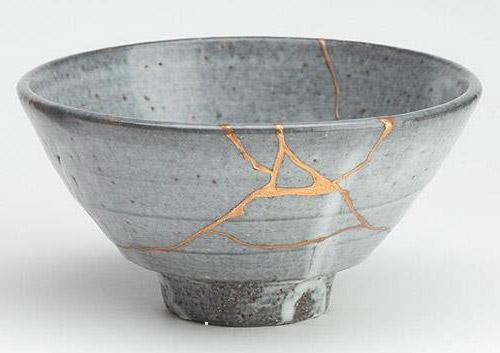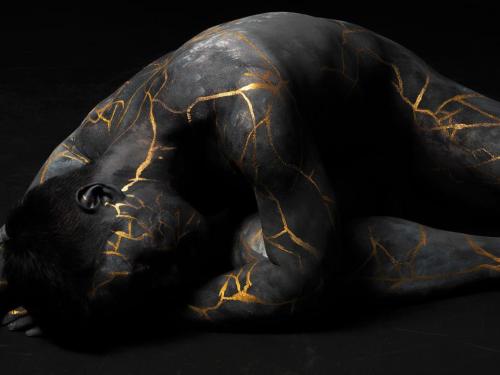Some thoughts on CHOREOPOP by Jesus de Vega and Chai Blaq
Text: Annet Huizing
In the course of last year, I had the opportunity to talk with choreographer Jesús de Vega. He was busy creating the project CHOREOPOP together with musician Chai Blaq (percussionist Michelle Samba) in the framework of a residency at Dansmakers. CHOREOPOP has since gone on tour and will soon be shown in Frascati, Amsterdam on 14 February with Loulou Elisabettie joining Jesús on stage. Time to revisit my notes, and to zoom in on two aspects that Jesús felt underlie the performance, and that joined Michelle’s and his work together: things broken and things Japanese.
CHOREOPOP is a choreographed music album, a hybrid between a dance performance, a pop music concert and live video-clips. Where body and voice become inseparable. Musician Chai Blaq and choreographer Jesús de Vega collaborate in this multidisciplinary project with the aim of merging two disciplines and their creative processes. They both find inspiration in things that seem broken: society, relationships, climate, bodies, etc.
When Michelle and Jesús first started the creative process together, in these explorative dialogues of getting to know each other’s focus, a shared interest in Japanese aesthetics and philosophy came to the fore. They agreed that for the piece: the choreography, the poetry and the visuals of it, they wanted to depart from the fragile, the delicate aspect and gradually arrived at things that are actually broken. They discovered a mutual interest, which was to become an inspiration for CHOREOPOP: the Japanese art of kintsugi.

Kintsugi is the ancient art of repairing what has been broken. Fragments of a shattered ceramic object are re-aligned and glued back together. The object is mended by using lacquer mixed with powdered gold that, importantly, leaves the repair visible. The repaired object, scarred with golden lines, becomes a symbol of fragility on the one hand, strength and beauty on the other. The mending process itself is never a ‘quick fix’. It is a meditative process that requires patience , a careful choosing of tools, and a mental engaging with the fragments and the patterns that arise when re-aligning them. All of this before the gold lacquer is even touched.
To find beauty in the imperfect is, Jesús told me, also related to the Japanese philosophy of wabi-sabi: “Wabi-sabi nurtures all that is authentic by acknowledging three simple realities: nothing lasts, nothing is finished, and nothing is perfect.” (1) It is specifically related to things natural: it is (amongst other things) the ability and mindset to find in imperfect objects something fascinating and beautiful. Fading autumn leaves and oxidized copper plate are examples from nature. Materials that age, in this philosophy, become more interesting as they change over time. This also applies to created objects: wabi-sabi gives a different perception of beauty, for instance when unevenness in an object, or in the alignment of a garden, makes it more interesting than perfect symmetry.
For Jesús both philosophies touched acutely upon his personal relationship with his body, which after some severe injuries (literally: broken joints, not put back together with gold lacquer but with metal pins) was no longer able to perform the way it was trained to, or the way Jesús’ mind had believed it always would work. Restoring faith in a body that has become wayward proved a long journey. Healing the body’s fractures was one thing; finding, and then acknowledging, a new beauty in its changed aesthetics and capacity for expression another.
Just as with kintsugi Jesús had to find his own materials and own tools, and take his own time to get to that point. The current production CHOREOPOP, to him, now is a “celebration of the healing power of unity as a way to repair social and emotional fractures”. But, to me, it also very much relates to the healing power of his own body and soul.
When reading more about kintsugi I learnt that the thought behind it is indeed often applied in psychology and mindfulness, where the beauty of repair is seen as a metaphor for life. “Like an object, life can break apart into a thousand pieces, but not for that reason should we stop living intensely […]. Emotional strength can be learned”, says psychologist Tomás Navarro, “Adversity is a collateral element of living, and everyone has a different way of coping. By being prepared for the inevitable, when challenging times happen, we can apply kintsugi. Instead of sweeping our problems under the metaphorical carpet, we can put ourselves back together in a way that embraces the challenges we have faced as part of our life’s journey, while acknowledging that it is our scars that make us strong and interesting people.”(2)
This view ties in with the perceptions I read in the introduction to a publication that came out last December: Phenomenology of the Broken Body: “Brokenness suggests a state in which the body is, in passing or permanently, hindered from what was perceived to be its normal functioning, being incapacitated or otherwise debarred from practical or social activities […]. Attending to the broken body […] can shed critical light back on what we otherwise take to be the normal body […] As we concentrate upon our tasks – riding a bicycle, typing an essay, digging a ditch [or, in Jesús’ case: dancing – AH] – the body on which we depend recedes into the background. But when the body breaks down, say by acute pain or a sudden onset of disease, the background converts into the foreground. Such fundamental interruptions have the power to disclose to us what tends to escape the familiar and habitual body; the breakdown […] not only opens up the broken state as such, but also opens up otherwise neglected dimensions of our bodily constitution[…]. (3) New limitations are often transformed into the conditions for new engagements.

For Jesús, personally, what he has come to expect from his body, has opened up new perceptions and possibilities as well and has changed the conditions for his choreographies: whereas formerly he would focus more on movement quality, he has now shifted the weight to what exactly he wants to tell. Tough stories sometimes, like in his earlier piece Glittergods/STIGMA which tackles the LGBTQ+ struggle, but strong and with a unique beauty.

© Annet Huizing, Cape Town, February 2019
Photo CHOREOPOP: Thomas Lenden
(1) Quote from: Wabi-Sabi Simple: Create beauty. Value imperfection. Live deeply , Richard Powell
(2) Kintsugi: why you should embrace your imperfections the Japanese way, article in the Telegraph by Boudicca Fox-Leonard, published 11-4-2018
(3) Phenomenology of the Broken Body, Espen Dahl, Cassandra Falke, Thor Eirik Eriksen, Routledge, December 2018


0 Comments